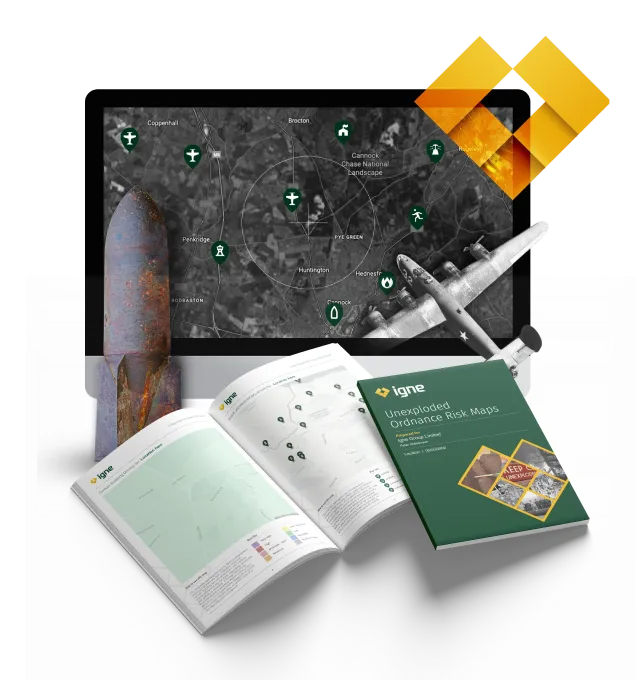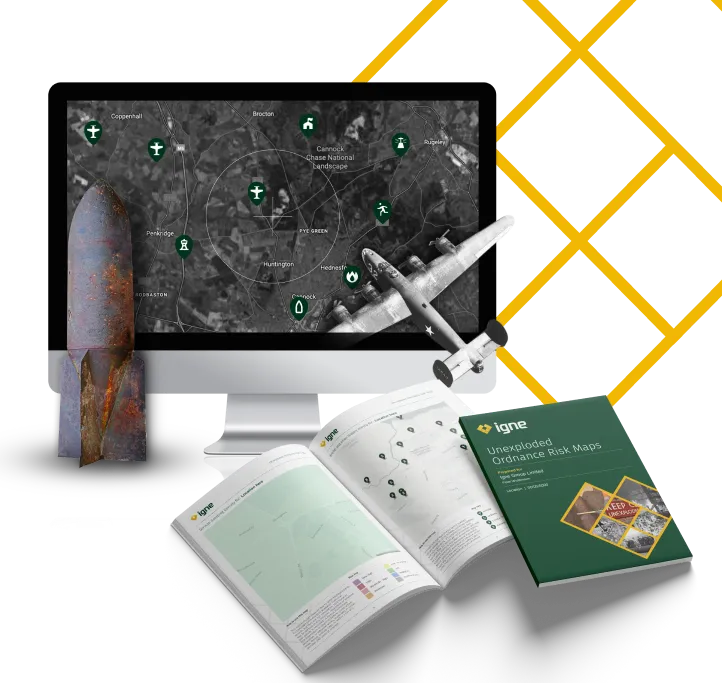
Woolwich Arsenal UXO risk assessment
Igne undertook a comprehensive stage 2 risk assessment on the site of the former Woolwich Arsenal.
Igne's in-house researchers undertake preliminary and detailed UXO risk assessments (in accordance with CIRIA C681) to help you understand your likely risk of encountering ordnance on your project site.
Preliminary and detailed UXO risk assessments are fundamental to the UXO unexploded ordnance risk mitigation process, playing a vital role in the consultancy phases of project planning. These assessments form the foundation for developing a safe, cost-effective, and streamlined risk management strategy for any residual UXO hazards on a site.
The preliminary UXO risk assessment is the initial step in this process. It evaluates the likelihood of encountering UXO at the project location. This assessment helps project managers understand the potential risks early on, allowing for informed decision-making and early mitigation strategies.
Once the preliminary assessment is complete, a detailed UXO risk assessment is conducted. This stage delves deeper, focusing specifically on the risks posed to the proposed works on the site. It provides a comprehensive analysis of how UXO might impact the project, identifying specific risks and recommending tailored mitigation measures.
Together, these assessments ensure that any UXO risks are thoroughly understood and managed, promoting a safer and more efficient project execution.

Stage 1
(Also known as a UXO PRA, Stage 1 UXO report, UXO hazard assessment or similar)
A preliminary risk assessment serves as an initial qualitative screening exercise to evaluate the potential presence of UXO at a given site. This process involves considering fundamental factors that influence the likelihood of UXO being present and the probability of any associated hazards occurring.
The primary objective of the PRA is to determine whether there is a need for more in-depth research, in the form of a detailed risk assessment, to further clarify the risk from UXO. By identifying or discounting the necessity for a detailed assessment, the preliminary assessment helps streamline the risk management process, ensuring that resources are allocated efficiently.
The preliminary UXO risk assessment examines various elements, such as the historical use of the site, previous military activities, and any evidence of ordnance disposal. This common-sense approach allows for an informed decision on the next steps, making it an essential first step in the comprehensive UXO risk management strategy.
By obtaining a preliminary UXO risk assessment, project managers can make early assessments of UXO risks, enabling proactive planning and mitigation measures. This initial screening ensures that any potential UXO hazards are identified and addressed promptly, contributing to a safer project environment and reducing the likelihood of costly delays.
Call: 01634 471 340 or email hello@igne.com to order your report.
CIRIA 681
According to the guidelines outlined in CIRIA 681 (UXO: A Guide for the Construction Industry), it is recommended that a preliminary UXO risk assessment effectively provides a hazard screening for a project. This initial assessment helps identify any need for more detailed consultation or risk mitigation strategies.
By conducting a preliminary assessment, project managers can gain a preliminary understanding of potential UXO hazards, which is crucial for early-stage project planning and compliance with health and safety regulations.
A preliminary risk assessment offers a low-cost and efficient method to ensure that all health and safety protocols are properly implemented from the onset. This early intervention can often eliminate the need for more extensive or last-minute survey work, allowing clients to adhere to safety guidelines promptly and avoid costly delays. The report acts as a proactive measure, addressing potential UXO risks before they escalate, thereby facilitating smoother project execution.
Moreover, a preliminary assessment frequently reveals that a detailed assessment is unnecessary, which results in significant time and cost savings for the project. By identifying the absence of UXO risks early on, the preliminary report helps streamline the risk management process and ensures that resources are allocated effectively.
This efficient approach not only enhances project safety but also optimises budget management, making the preliminary UXO risk assessment an invaluable tool in the UXO risk mitigation framework.
Call: 01634 471 340 or email hello@igne.com to order your detailed risk assessment.
A preliminary UXO risk assessment conducted by Igne harnesses a wealth of in-house information sources to place a development project within the broader context of domestic military and conflict history.
This assessment delves into various critical factors to ensure a comprehensive evaluation of potential UXO risks.
The preliminary report examines the extent of the proposed works, evaluating the scope and scale of the development to understand its potential impact on and interaction with any existing UXO hazards. It also investigates the conflict history of the area, including specific enemy actions that may have contributed to the presence of UXO.
In addition to historical conflicts, the preliminary assessment considers domestic military activities, encompassing aerial, naval, and land-based operations.
By analysing these operations, the assessment can identify areas that were subject to intensive military actions and, therefore, might have a higher likelihood of containing UXO.
Furthermore, the preliminary report takes into account any existing risk mitigating factors that could reduce the potential hazards associated with UXO. These might include prior UXO clearance efforts, post-war site redevelopment, or other conditions that could influence the presence and stability of UXO.
Igne’s preliminary risk assessment process begins with an in-depth analysis of its extensive internal database, which includes bombing density maps, bomb plot mappings, and detailed records of British and Allied military activities.
This robust data foundation is crucial for identifying potential UXO risks. Subsequently, Igne consults additional publications and historical documents to expand on specific details and ensure the accuracy and thoroughness of the assessment.
A general overview of the area is also conducted, incorporating broader historical and geographical context into the PRA. This holistic approach ensures that all relevant factors are considered, providing a detailed and reliable assessment that guides further risk mitigation strategies and ensures the safety and success of the development project.
Igne possesses an extensive database that includes bombing density maps, detailed statistics, bomb plot maps, and records of British and Allied military activities. This rich repository of information serves as the foundational step in producing any preliminary UXO risk assessment.
By leveraging this comprehensive internal database, Igne can accurately assess potential UXO risks.
Following this initial data analysis, Igne consults a wide range of available publications to further expand on necessary details.
This may include historical documents, military records, and other relevant literature that provide additional context and depth to the assessment. By incorporating these external sources, Igne ensures that the preliminary assessment is thorough and well-informed.
Additionally, as part of the hazard screening exercise, Igne conducts a general overview of the area in question. This involves examining broader historical and geographical contexts to identify any factors that may influence the presence and risk of UXO.
By combining detailed internal data with external publications and a holistic area overview, Igne delivers a comprehensive and reliable preliminary UXO risk assessment. This process not only identifies potential UXO hazards but also informs subsequent risk mitigation strategies, ensuring the safety and success of development projects.
Check your site’s UXO risk instantly,
Covers every threat from air raids to military targets.
No cost. No waiting.
Just intelligent, location-specific insight in seconds.

Igne undertook a comprehensive stage 2 risk assessment on the site of the former Woolwich Arsenal.
Provision of detailed risk assessment of a residential estate within a central London Borough, prior to its demolition and redevelopment.
Igne provided preliminary risk assessments for 46 sites in the South East of England, prior to the refurbishment and installation of water mains.
Stage 2
What is a Stage 2 Detailed UXO Risk Assessment (DRA)
(Also known as a UXO DRA, UXO desktop report, UXO threat assessment or similar)
A detailed UXO risk assessment is a tailored and thorough report evaluating the potential risk posed by unexploded ordnance (UXO) to your proposed project. This detailed UXO report investigates the potential extent of contamination, identifying both the source and nature of likely explosive contaminants. It also assesses the likelihood and potential consequences of encountering UXO in relation to the intended use of the site.
Often carried out in the early stages of project planning, a desktop risk assessment ensures cost and time efficiency within the broader project scope. Conducting the assessment before any intrusive on-site work begins is key.
Many clients may choose to proceed directly with a detailed risk assessment, bypassing the preliminary risk assessment, if they are already aware that their site is in a heavily bombed area or was previously used by the military, such as an airfield, training area, or firing range. This approach allows for the swift development of a detailed mitigation strategy based on the findings of the report.
The risk assessment process involves several stages of research, encompassing all available historical and modern records. This comprehensive approach provides clients with a clear understanding of the risks present on the site and outlines strategies to mitigate them effectively. The goal is to ensure that all potential hazards are identified and addressed, promoting the safe and efficient progress of the project.
What does a DRA include?
The primary objective of a detailed risk assessment is to evaluate the likelihood of encountering and potentially detonating explosive ordnance during intrusive activities at a project site. If the assessment identifies an elevated risk, it will recommend appropriate risk mitigation measures in accordance with CIRIA C681 guidelines.
These measures are designed to minimise the risk of UXO detonation and the associated potential for harm and damage during the planned works, ensuring that the risks are managed to ‘as low as reasonably practicable’ (ALARP).
A detailed UXO risk assessment is considered a dynamic document that must be updated whenever there are changes to the proposed works or if UXO is discovered during the project. It is crucial for maintaining the accuracy and relevance of the risk management strategy throughout the project lifecycle.
The report will incorporate all available and pertinent historical information related to the site and its surrounding area. This includes detailed historical context to help both the risk assessor and the client understand the site’s background.
Additionally, the assessment will integrate relevant modern information, including post-WWII mitigation efforts that might impact the current risk evaluation.
Igne’s detailed risk assessments are comprehensive and include visual aids such as maps, images, and other data that help to contextualise the information. These resources are available in GIS formats upon request, enhancing the utility and accessibility of the data.
The report will also provide general information about the types of ordnance commonly found on UK construction sites, offering further insight into the types of hazards that may be encountered.
This thorough approach ensures that all aspects of UXO risk are considered and managed effectively.
Legal Duties
Legal duties and responsibilities – do I have to get a risk assessment?
UXO is often not recognised as a significant hazard during construction and planning phases. This underestimation can be attributed to several factors. Firstly, the frequency of UXO discoveries, particularly those originating from German air raids as opposed to former military lands, is relatively low.
Additionally, since 1949, there have been no recorded fatalities directly caused by UXO, which has contributed to a misconception that UXO is not a pressing threat to ongoing projects.
However, current development trends suggest that the likelihood of encountering UXO is increasing. The growing demand for new housing and infrastructure, especially on land recently released from military use, raises the potential for UXO discoveries.
Moreover, the trend towards constructing taller buildings with deeper foundations on brownfield sites means that ground disturbances are occurring for the first time since WWII. This increases the risk of uncovering UXO, making it imperative for operatives to implement robust risk management and control measures to ensure safety and protect assets and the environment.
While there is no specific legal requirement solely focused on managing UXO risks, the hazard is addressed under broader health and safety legislation.
According to the Construction (Design and Management) Regulations 2015 (CDM 2015), clients are responsible for overseeing the overall health and safety approach of a project. This includes providing essential pre-construction information such as UXO risk assessments and clearance records.
Clients must also ensure that adequate risk management arrangements are in place, including emergency response plans for potential UXO encounters.
Designers have a duty to anticipate and mitigate foreseeable risks related to construction works. They are required to create hazard registers and conduct risk assessments, particularly when dealing with significant hazards like UXO.
Designers should collaborate with UXO risk assessors and provide detailed information about the proposed groundworks.
Contractors are responsible for planning and managing construction activities in a manner that minimises safety risks. They must ensure that their workforce is protected through appropriate method statements, risk assessments for known or suspected hazards (including UXO), and effective emergency response plans.
Additionally, common law imposes responsibilities on land and building owners, especially regarding the safety of invitees, licensees, and even trespassers. This is particularly relevant for owners of former military sites where residual UXO hazards may be present.
Given these considerations, it is strongly recommended that all land-based projects in the UK incorporate UXO considerations into their hazard screening processes. Implementing a UXO emergency response plan is crucial to safely manage any potential encounters and ensure the protection of all parties involved.
What UXO issues will be addressed?
Igne’s detailed UXO risk assessments will comprehensively address several critical issues related to UXO at a project site. The assessment will evaluate the following factors:
In addition to addressing these key issues, the assessment will provide recommendations for appropriate risk mitigation measures to reduce the risk to ‘as low as reasonably practicable’ (ALARP). These recommendations will be tailored to the specific risk rating, the characteristics of the site, and the nature of the planned works.
By offering targeted mitigation strategies, the report ensures that all identified risks are managed effectively and that safety measures are in place to protect personnel, equipment, and the environment.
To evaluate the risk of UXO at a project site, Igne conducts a comprehensive assessment of site-specific factors. This detailed examination includes:
By carefully analysing these factors, Igne ensures a thorough understanding of the UXO risks associated with the site. This comprehensive approach allows for accurate risk assessment and the development of appropriate mitigation strategies to ensure the safety and success of the project.
Check your site’s UXO risk instantly,
Covers every threat from air raids to military targets.
No cost. No waiting.
Just intelligent, location-specific insight in seconds.

What sources of information does Igne use for its detailed UXO risk assessments?
When conducting a detailed UXO risk assessment, Igne undertakes a thorough examination of a broad spectrum of historical and contemporary sources to obtain a comprehensive understanding of the site’s context. This approach ensures that all relevant and available information is considered, which can vary depending on the project's location.
Igne possesses one of the largest UXO databases in the country, a valuable resource that includes datasets accumulated since the 1990s and continuously updated. This extensive database encompasses information from a variety of sources such as national and local archives, public records, military archives, academic publications, and other relevant materials.
Each project benefits from this rich repository of data, which is consulted to provide a solid foundation for the risk assessment.
In cases where certain datasets are lacking or information for a specific location is limited, the Igne team will make site visits to local archives to gather additional data. This proactive approach ensures that any gaps in the information are filled, providing a more complete picture of the site's history and potential risks.
Additionally, Igne collaborates with trusted suppliers to obtain historical maps and photographs, which are crucial for understanding changes to the project site over time. These visual resources can reveal significant details such as the presence of bomb craters or ruins, contributing to a more accurate risk assessment.
Beyond these sources, Igne also consults geological databases, museums, heritage assessments, archaeological studies, and other relevant references.
By integrating information from these diverse sources, Igne ensures that the assessment is as thorough and precise as possible, allowing for effective risk management and informed decision-making for the project.
How reliable or useful are historical or bombing records?
During WWII, significant efforts were made to document enemy air raids. Air Raid Precautions (ARP) wardens were tasked with recording details of bomb strikes, either through direct observation or post-raid surveys.
However, their primary focus was on managing casualties and mitigating damage, which often led to incomplete and occasionally contradictory records. The initial record-keeping efforts during the early stages of the bombing were not thorough, and many details from the beginning of the war were lost due to subsequent attacks that destroyed earlier documentation.
Some reports might cover individual raids, while others may span several months or even the entire duration of the war.
Records of raids on sparsely populated or uninhabited areas were often based on third-party accounts or hearsay, which can affect their reliability. Additionally, records related to attacks on military or strategic targets were usually maintained separately from general records and have not always been preserved.
The accuracy and completeness of wartime records can vary significantly from one location to another. Verifying the precision of these records is often challenging, if not impossible.
Consequently, determining the exact location, quantity, and nature of ordnance risks cannot be definitive. Instead, it relies on the careful accumulation and analysis of all available evidence, understanding that the historical data may be incomplete or fragmented.
Quantitative vs qualitative risk assessing
To establish risk ratings and recommend suitable mitigation measures, Igne employs a semi-quantitative assessment approach.
This method is designed to evaluate the level of risk associated with the planned activities at a project site.
The assessment process involves identifying potential hazards, investigating the possible receptors that could be impacted, and analysing the pathways through which these hazards might affect the site. This relationship is commonly described using the Source–Pathway–Receptor model.
The risk rating for a site is determined by several key factors: the likelihood that UXO remains on the site, the probability of encountering or initiating UXO during the proposed activities, and the potential consequences of an accidental detonation.
Each factor is assigned a numerical value on a scale of 1 to 5, and these values are analysed using a risk matrix to derive the overall risk rating.
The result is categorised into risk levels—Low, Medium, or High—based on the total score. This rating is applied to each identified weapon type (source) that poses a potential threat to the project.
This semi-quantitative approach offers a clear and structured explanation of the risk rating, as it integrates both numerical and qualitative assessments. It provides a more comprehensive understanding than a purely qualitative approach, which might leave readers to interpret the rationale behind the risk rating themselves.
Conversely, a purely quantitative approach would be inadequate for UXO risk assessment, as it relies heavily on variable data that may not capture the full complexity of the situation.
By combining both quantitative and qualitative elements, Igne’s method ensures a more accurate and transparent evaluation of UXO risks.
Are Igne’s UXO risk assessments impartial?
At Igne, integrity is the cornerstone of our operations and approach to risk assessment. A common misconception is that companies providing mitigation services might intentionally inflate risk ratings to secure additional work. This notion is fundamentally contrary to Igne's principles and practices.
Our dedicated research team meticulously gathers and analyses a comprehensive range of data to construct a precise understanding of the potential hazards on a site. Each report we produce is based on thorough analysis and is designed to provide a clear, accurate depiction of the risks involved.
Our commitment to integrity means we are devoted to ensuring that our clients only undertake site work that is necessary and safe. We strive to avoid any unnecessary actions or costs.
Furthermore, we frequently assist with quality assurance (QA) and quality control (QC) of risk assessments conducted by other industry professionals. We strongly encourage project leads to seek independent reviews or second opinions if they have any doubts about the findings or conclusions of their risk assessments.
Obtaining a second opinion can provide valuable clarity and help ensure that all decisions are based on the most accurate and reliable information available. This commitment to integrity and accuracy reinforces our dedication to the safety and success of every project we undertake.
Recommendations
Effective UXO risk management is an important aspect of any construction or development project. UXO, originally designed to cause harm, continues to pose a significant residual risk long after its initial use. This risk is not only a safety concern but also carries substantial commercial implications.
The potential for UXO incidents can lead to severe delays and disruptions in project timelines, which in turn can result in increased costs. These disruptions can affect various stages of a project, from initial planning and excavation to construction and completion. The financial repercussions of such delays are significant, often impacting project budgets and profitability.
In addition to the immediate operational impacts, UXO risks can also affect the long-term financial value of the land. Properties with unresolved UXO issues may experience decreased market value due to the perceived or real hazards, affecting the land’s desirability and financial return.
Land and building owners bear the responsibility for managing residual UXO risks. This obligation includes ensuring that proper risk assessments and mitigation strategies are in place to address any potential threats. Failure to manage these risks effectively can result in legal liabilities and further financial burdens, making proactive risk management an essential part of property and project management.
Overall, addressing UXO risks comprehensively is vital for safeguarding both the safety of personnel and the financial viability of projects, ensuring that potential hazards are managed efficiently to minimise their impact on development activities and property values.
About Igne’s research team and process
Igne’s risk assessments are meticulously produced by a dedicated in-house team of experienced researchers. Boasting over 25 years of combined expertise, our team ensures that each risk assessment is thorough and well-supported.
A lead researcher, who serves as your primary point of contact throughout the process, is responsible for the preparation of each report. This lead researcher will coordinate all aspects of the assessment, gathering comprehensive records, data, historical archives, maps, photographs, and any other pertinent information related to your project site.
Once all relevant details have been collected, the lead researcher will meticulously map and analyse this information to determine the final risk rating. Each risk assessment is not only compiled by the lead researcher but also undergoes a rigorous review process involving the entire research team.
This collaborative approach ensures that the assessment benefits from a diverse range of insights and expertise.
To further enhance the accuracy and reliability of the report, each project is discussed with our Explosive Ordnance Disposal (EOD)-trained personnel and research manager. This additional layer of scrutiny guarantees that the final report meets high standards of quality and precision.
For your convenience, we provide all available mapping data in PDF format, and GIS files are available upon request. This ensures that you have access to detailed and useful visual resources to support your project planning and risk management efforts.
For more information regarding any of our unexploded ordnance (UXO) solutions, contact Igne today
Email: hello@igne.comCall: 0371 789 1000


